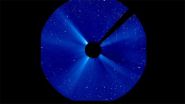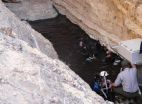(Press-News.org) A space weather storm from the sun engulfed our planet on Jan. 21, 2005. The event got its start on Jan. 20, when a cloud of solar material, a coronal mass ejection or CME, burst off the sun and headed toward Earth. When it arrived at our planet, the ring current and radiation belts surrounding Earth swelled with extra particles, while the aurora persisted for six hours. Both of these are usually signs of a very large storm – indeed, this was one of the largest outpouring of solar protons ever monitored from the sun. But the storm barely affected the magnetic fields around Earth – disturbances in these fields can affect power grids on the ground, a potential space weather effect keenly watched for by a society so dependent on electricity
Janet Kozyra, a space scientist at the University of Michigan in Ann Arbor, thought this intriguing combination of a simultaneously weak and strong solar storm deserved further scrutiny. In an effort to better understand -- and some day forecast -- such storms and their potential effects on human technology, an unusual event like this can help researchers understand just what aspects of a CME lead to what effects near Earth.
"There were features appearing that we generally only see during extreme space weather events, when by other measures the storm was moderate," said Kozyra. "We wanted to look at it holistically, much like terrestrial weather researchers do with extreme weather. We took every single piece of data that we could find on the solar storm and put it together to see what was going on."
With observations collected from ground-based networks and 20 different satellites, Kozyra and a group of colleagues, each an expert in different aspects of the data or models, found that the CME contained a rare piece of dense solar filament material. This filament coupled with an unusually fast speed led to the large amount of solar material observed. A fortuitous magnetic geometry, however, softened the blow, leading to reduced magnetic effects. These results were published in the Aug. 14, 2014, issue of Journal of Geophysical Research, Space Physics.
The researchers gathered data from spacecraft orbiting in Earth's ionosphere, which extends up to 600 miles above the planet's surface, and satellites above that, orbiting through the heart of Earth's magnetic environment, the magnetosphere. The massive amount of data was then incorporated into a variety of models developed at the University of Michigan's Center for Space Environment Modeling, which are housed at the Community Coordinated Modeling Center at NASA's Goddard Space Flight Center in Greenbelt, Maryland, a facility dedicated to providing comprehensive access to space weather models.
With the models in hand, the team could put together the story of this particular solar storm. It began with the CME on Jan. 20, 2005. The European Space Agency and NASA's Solar and Heliospheric Observatory, or SOHO, captured images of the CME. At their simplest, CMEs look like a magnetic bubble with material around the outside. In this case, there was an additional line of colder, denser solar material – an electrically charged gas called plasma – inside called a solar filament. Solar filaments are ribbons of dense plasma supported in the sun's outer atmosphere – the corona -- by strong magnetic fields. Filament material is 100 times denser and 100 times cooler than the surrounding atmosphere. When the supporting magnetic fields erupt, the filaments are caught up in the explosive release that forms the CME. Despite observations that the majority of eruptions like this involve solar filaments, the filaments are rarely identified in disturbances that reach Earth. Why this might be, is a mystery – but it means that the presence of the solar filament in this particular event is a rare sighting.
Subsequent observations of the CME showed it to be particularly fast, with a velocity that peaked at around 1800 miles per second before slowing to 600 miles per second as it approached Earth. Just how many CMEs have filaments or how the geometry of such filaments change as they move toward Earth is not precisely known. In this case, however, it seems that the dense filament sped forward, past the leading edge of the CME, so as it slammed into the magnetosphere, it delivered an extra big dose of energetic particles into near-Earth space.
What happened next was observed by a flotilla of Earth-orbiting scientific satellites, including NASA's IMAGE, FAST and TIMED missions, the joint European Space Agency, or ESA, and NASA's Cluster, the NASA and ESA's Geotail, the Chinese and ESA's Double Star-1; other spacecraft 1 million miles closer to the sun including SOHO and NASA's Advanced Composition Explorer, Wind various other spacecraft; as well as the National Science Foundation-supported ground-based SuperDARN radar network. At the time Cluster was in the solar wind directly upstream of Earth. Meanwhile, Double Star-1 was passing from the outer region of the planet's magnetic field and entering the magnetosphere. This enabled it to observe the entry of the solar filament material as it crossed into near-Earth space.
"Within one hour of the impact, a cold, dense plasma sheet formed out of the filament material," said Kozyra. "High density material continued to move through the magnetosphere for the entire six hours of the filament's passage."
Despite the intense amount of plasma carried by the CME, it still lacked a key component of a super storm. The magnetic fields embedded in this CME generally pointed toward Earth's north pole, just as Earth's own magnetic fields do. This configuration causes far fewer disruptions to our planet's system than when the CME's fields point southward. When pointing south, the CME's fields clash with Earth's, peeling them back and setting off magnetic perturbations that cascade through the magnetosphere.
The magnetic field orientation is what kept this solar storm to low levels. On the other hand, the extra solar material from the filament catalyzed long-term aurora over the poles and enhanced the particle filled radiation belts around Earth, characteristic of a larger storm.
"This event, with its unusual combination of space weather effects really demonstrates why it's important to look at the entire system, not just individual elements," said Kozyra. "Only by using all of this data, by watching the event from the beginning to the end, can we begin to understand all the different facets of an extreme storm like this."
Understanding what created the facets of this particular 2005 storm adds to a much larger body of knowledge about how different kinds of CMEs can affect us here at Earth. By knowing what factors lead to the total strength of a storm, we can better learn to predict what the sun is sending our way.
INFORMATION:
This work was supported by NASA's Heliophysics Division, in combination with the National Science Foundation's Division of Atmospheric and Geospace Sciences.
Researchers use NASA and other data to look into the heart of a solar storm
2014-08-28
ELSE PRESS RELEASES FROM THIS DATE:
After Great Recession, Americans are unhappy, worried, pessimistic, Rutgers study finds
2014-08-28
NEW BRUNSWICK, N.J. – The protracted and uneven recovery from the Great Recession has led most Americans to conclude that the U.S. economy has undergone a permanent change for the worse, according to a new national study at Rutgers. Seven in 10 now say the recession's impact is permanent, up from half in 2009 when the recession officially ended, according to the John J. Heldrich Center for Workforce Development.
Among key findings in "Unhappy, Worried and Pessimistic: Americans in the Aftermath of the Great Recession," the center's latest Work Trends report, are:
Despite ...
A VA exit strategy
2014-08-28
LEBANON, NH – As the federal government plans its exit strategy from the war, now may be the time for it to rethink its role in providing health care to veterans, says a Perspective piece in the New England Journal of Medicine.
"To simply go on doing more of the same is to fail to recognize the challenge that the Veterans Health Administration's cost and population structure pose in the longer run," said William Weeks, from The Dartmouth Institute for Health Policy & Clinical Practice, and David Auerbach, from the RAND Corporation, in the August issue of NEJM.
The ...
The universal 'anger face'
2014-08-28
The next time you get really mad, take a look in the mirror. See the lowered brow, the thinned lips and the flared nostrils? That's what social scientists call the "anger face," and it appears to be part of our basic biology as humans.
Now, researchers at UC Santa Barbara and at Griffith University in Australia have identified the functional advantages that caused the specific appearance of the anger face to evolve. Their findings appear in the current online edition of the journal Evolution and Human Behavior.
"The expression is cross-culturally universal, and even ...
Climate change puts endangered Devils Hole pupfish at risk of extinction
2014-08-28
RENO, Nev. – Climate change is hurting reproduction of the endangered Devils Hole pupfish, threatening the survival of this rare species that has numbered as few as 35 individuals, new research by the University of Nevada, Reno and Desert Research Institute shows.
Scientists report that geothermal water on a small shelf near the surface of an isolated cavern in the Nevada desert where the pupfish live is heating up as a result of climate change and is likely to continue heating to dangerous levels.
The hotter water, which now reaches more than 93 degrees, has shortened ...
Deadly remedy: Warning issued about Chinese herbal medicine
2014-08-28
A herbal preparation prescribed by a Chinese herbal medication practitioner in Melbourne for back pain resulted in life-threatening heart changes, prompting a team of intensive care and emergency physicians to call for appropriate patient education by practitioners who prescribe complementary medications.
Writing in Emergency Medicine Australasia, the journal of the Australasian College for Emergency Medicine, emergency medicine trainees Dr Angelly Martinez and Dr Nicky Dobos from the Intensive Care Unit at the Royal Melbourne Hospital and emergency medicine trainee Dr ...
Are cigarette substitutes a safe alternative? It depends on user habits
2014-08-28
CORAL GABLES, Fla (Aug. 26, 2014)-- Cigarette smoking kills approximately 440,000 Americans each year, according to the Centers for Disease Control and Protection. It's the leading cause of preventable death worldwide. In order to overcome this addiction, many people resort to nicotine replacement therapies.
A recent literature review study by researchers at the University of Miami (UM) suggest that small dosages of nicotine found in cigarette substitutes could be harmful to human musculoskeletal system, due to overuse. The findings are reported in the Global Journal ...
From bite site to brain: How rabies virus hijacks and speeds up transport in nerve cells
2014-08-28
Rabies (and rabies virus, its causative agent) is usually transmitted through the bite of an infected animal into muscle tissue of the new host. From there, the virus travels all the way to the brain where it multiplies and causes the usually fatal disease. An article published on August 28th in PLOS Pathogens sheds light on how the virus hijacks the transport system in nerve cells to reach the brain with maximal speed and efficiency.
Pathogens that travel in the blood can spread throughout the body without much effort, courtesy of the heart's pumping action. Those traveling ...
Genomic sequencing reveals mutations, insights into 2014 Ebola outbreak
2014-08-28
In response to an ongoing, unprecedented outbreak of Ebola virus disease (EVD) in West Africa, a team of researchers from the Broad Institute and Harvard University, in collaboration with the Sierra Leone Ministry of Health and Sanitation and researchers across institutions and continents, has rapidly sequenced and analyzed more than 99 Ebola virus genomes. Their findings could have important implications for rapid field diagnostic tests. The team reports its results online in the journal Science.
For the current study, researchers sequenced 99 Ebola virus genomes collected ...
Radio telescopes settle controversy over distance to Pleiades
2014-08-28
Astronomers have used a worldwide network of radio telescopes to resolve a controversy over the distance to a famous star cluster -- a controversy that posed a potential challenge to scientists' basic understanding of how stars form and evolve. The new work shows that the measurement made by a cosmic-mapping research satellite was wrong.
The astronomers studied the Pleiades, the famous "Seven Sisters" star cluster in the constellation Taurus, easily seen in the winter sky. The cluster includes hundreds of young, hot stars formed about 100 million years ago. As a nearby ...
New research reveals how wild rabbits were genetically transformed into tame rabbits
2014-08-28
The genetic changes that transformed wild animals into domesticated forms have long been a mystery. An international team of scientists has now made a breakthrough by showing that many genes controlling the development of the brain and the nervous system were particularly important for rabbit domestication. The study is published today in Science and gives answers to many genetic questions.
The domestication of animals and plants, a prerequisite for the development of agriculture, is one of the most important technological revolutions during human history. Domestication ...




